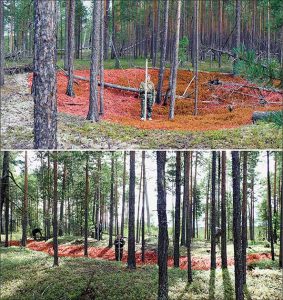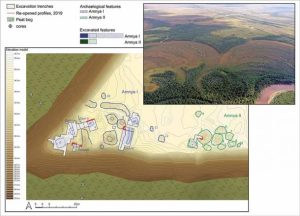Siberia’s World’s Oldest Fortress Casts Doubt on Conventional Archaeology

The world’s oldest fortress has been discovered in Siberia, dating to 8,000 years ago. This defensive complex reveals an ancient class structure, and like Göbekli Tepe in Turkey, it challenges traditional views about the lifestyles of hunter-gatherers.
Built by hunters-gatherers in Siberia around 8,000 years ago, archaeologists have discovered the world’s oldest fortress. Known as The Amnya I and II fortress, historians claim this structure will greatly assist them in understanding how complex hunter-gatherer societies evolved in the Mesolithic period.
Surrounded by sand on a bank of the Amnya River, sediment, soil, and debris analysis of a study recently published in Antiquity have determined that the defensive site was burned to the ground several times. Furthermore, the discovery of arrowheads in the outer ditch speaks of violent conflict in the region, as groups of hunter-gatherers battled for control of the most abundant fishing spots.
Cooperation Between Hunter-gatherers Accelerated Human Evolution
Slate Stone Age ‘Friendship Rings’ Found in Finland
Clues Suggest a Hierarchical Structure
A report in IFLScience explains that between from 1987 and 2000, archaeologists identified a series of wooden palisades. These fence-like structures were crafted from wooden stakes, or logs driven into the ground, forming a fortification to protect a settlement or camp from external threats.
Colin Grier of Washington State University told Science.org that Amnya I is defined by the remains of “10 pit depressions.” A further 10 huts, found outside the fortified structure, suggest “a hierarchical structure.” While those in the inner fortified area enjoyed a degree of protection, those living outside, in Amnya II, served as a front line of defense.
Grier said this architectural format speaks of “property ownership and social inequality,” which he said people have been thinking about “since we became human”.

Amnya I, structures in the surface relief (locations highlighted). Top: depression of pit house 5; bottom: outer defence line with bank and ditch III (E. Dubovtseva/Antiquity Publications Ltd)
Analyzing Ancient Animal Bones and Pottery
The researchers determined the age of the site with radiocarbon dating, which confirmed it as “the world’s oldest-known fort,” and the discovery of central elevated fireplaces further determined that the structures were “long-term dwellings”.
The team recovered 45 pottery vessels with both pointed, and flat bases. The former are decorated with “incised ornament,” and the second with a “comb stamp” pattern. Furthermore, the researchers analyzed elk, reindeer, and beaver bones, to better understand the hunting and dietary patterns of the dwellers, who lived in this fortress around 8,000-years-ago.
An Unparalleled Phenomenon
The team of archaeologists said the Amnya fort “was built many centuries before comparable enclosures first appeared in Europe, and that the early onset of this phenomenon in inland western Siberia “is unparalleled.” And similar to Göbekli Tepe in Turkey, this site also challenged the idea that permanent settlements, religious and defensive structures emerged with the birth of farming.
Previously, archaeologists had associated competition and conflict for resources with the Neolithic period, and not with earlier Mesolithic hunter-gatherer societies. The scientists said the ancient fortress “reshapes our understanding of early human societies, challenging the idea that only with the advent of agriculture would people have started to build permanent settlements with monumental architecture and have developed complex social structures”.

Top: aerial view of the Amnya river and promontory; bottom: general plan of Amnya I and II, showing location of excavation trenches and features visible in the surface relief (illustration by N. Golovanov, S. Krubeck & S. Juncker/ Antiquity Publications Ltd).
Fortified Landscapes Before the Rise of Farming
Colin Grier said, “new palaeobotanical and stratigraphical examinations” reveal that Western Siberian led “a sophisticated lifestyle based on the abundant resources of the taiga environment.” The taiga, also known as the “boreal forest,” is a biome characterized by its cold climate and dominated by coniferous trees.
Evidence was also found that the Amnya I house pits were re-occupied in the early 6th century BC, and a fourth possible reoccupation in some of the Amnya II house pits occurred during the 4th century BC, in the Eneolithic phase.
In conclusion, the fortress marks the oldest hunter-gatherer defensive site in the north of Eurasia, and demonstrates that permanent fortified settlements were built a long time before the rise of the first farmers.